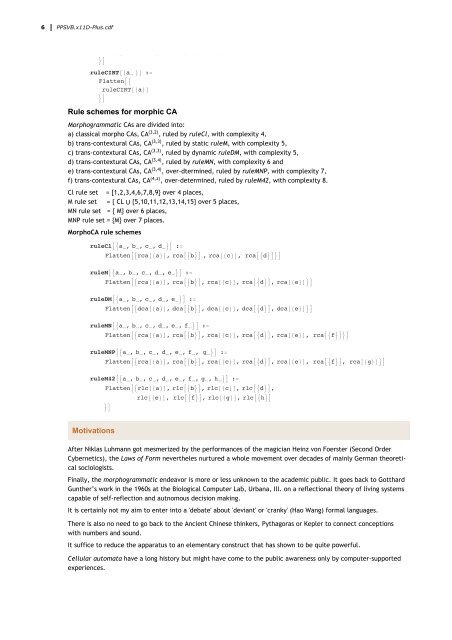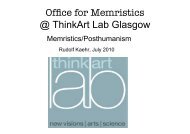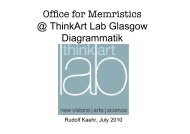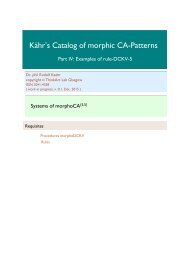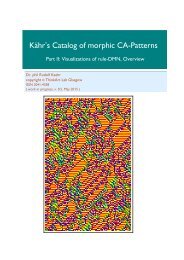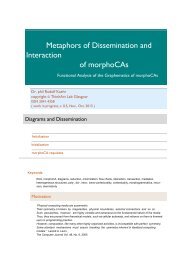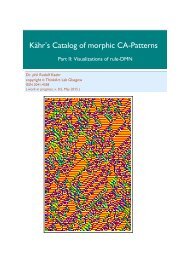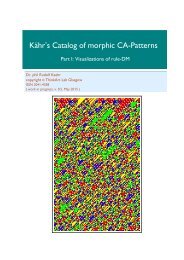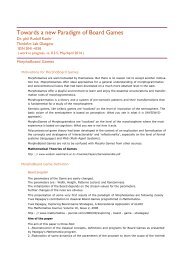A Kind of a New Music Box
A Tool Box for sonic and visual deep-structural adventures by comparing classical, indicational and morphic CA. Motto: If words are not going to be listened to and notions are not going to be understood, there is still a chance of showing some pictures and making some noise, with an offer to motivate to enjoy or to conceive their differences and also to try to overcome the attitude of blind and deaf denial of conceptual thinking. Interactivity for Sound and Visualizations needs the formats Wolfram CDF or HTML. http://www.thinkartlab.com/Memristics/PPSVB-Plus/PPSVB.x11D-Plus.html , soundtracks at: https://soundcloud.com/morphicalgorithms/tracks, more information at: http://the-chinese-challenge.blogspot.co.uk
A Tool Box for sonic and visual deep-structural adventures
by comparing classical, indicational and morphic CA.
Motto:
If words are not going to be listened to and notions are not going to be understood, there is still a chance of showing some pictures and making some noise, with an offer to motivate to enjoy or to conceive their differences and also to try to overcome the attitude of blind and deaf denial of conceptual thinking. Interactivity for Sound and Visualizations needs the formats Wolfram CDF or HTML. http://www.thinkartlab.com/Memristics/PPSVB-Plus/PPSVB.x11D-Plus.html , soundtracks at:
https://soundcloud.com/morphicalgorithms/tracks, more information at: http://the-chinese-challenge.blogspot.co.uk
Create successful ePaper yourself
Turn your PDF publications into a flip-book with our unique Google optimized e-Paper software.
6 PPSVB.x11D-Plus.cdf<br />
rci[{p}], rci[{q}], rci[{r}], rci[{s}]<br />
<br />
ruleCIRT[{a_ }] :=<br />
Flatten<br />
ruleCIRT[{a}]<br />
<br />
Rule schemes for morphic CA<br />
Morphogrammatic CAs are divided into:<br />
a) classical morpho CAs, CA (3,2) , ruled by ruleCl, with complexity 4,<br />
b) trans-contextural CAs, CA (3,3) , ruled by static ruleM, with complexity 5,<br />
c) trans-contextural CAs, CA (3,3) , ruled by dynamic ruleDM, with complexity 5,<br />
d) trans-contextural CAs, CA (3,4) , ruled by ruleMN, with complexity 6 and<br />
e) trans-contextural CAs, CA (3,4) , over-dtermined, ruled by ruleMNP, with complexity 7,<br />
f) trans-contextural CAs, CA (4,2) , over-determined, ruled by ruleM42, with complexity 8.<br />
Cl rule set = [1,2,3,4,6,7,8,9} over 4 places,<br />
M rule set = { CL ⋃ {5,10,11,12,13,14,15} over 5 places,<br />
MN rule set = { M} over 6 places,<br />
MNP rule set = {M} over 7 places.<br />
MorphoCA rule schemes<br />
ruleCla_, b_, c_, d_ :=<br />
Flattenrca[{a}], rcab , rca[{c}], rcad<br />
ruleMa_, b_, c_, d_, e_ :=<br />
Flattenrca[{a}], rcab, rca[{c}], rcad, rca[{e}]<br />
ruleDMa_, b_, c_, d_, e_ :=<br />
Flattendca[{a}], dcab, dca[{c}], dcad, dca[{e}]<br />
ruleMNa_, b_, c_, d_, e_, f_ :=<br />
Flattenrca[{a}], rcab, rca[{c}], rcad, rca[{e}], rcaf<br />
ruleMNPa_, b_, c_, d_, e_, f_, g_ :=<br />
Flattenrca[{a}], rcab, rca[{c}], rcad, rca[{e}], rcaf, rca[{g}]<br />
ruleM42a_, b_, c_, d_, e_, f_, g_, h_ :=<br />
Flattenrlc[{a}], rlcb, rlc[{c}], rlcd,<br />
rlc[{e}], rlcf, rlc[{g}], rlch<br />
<br />
Motivations<br />
After Niklas Luhmann got mesmerized by the performances <strong>of</strong> the magician Heinz von Foerster (Second Order<br />
Cybernetics), the Laws <strong>of</strong> Form nevertheles nurtured a whole movement over decades <strong>of</strong> mainly German theoretical<br />
sociologists.<br />
Finally, the morphogrammatic endeavor is more or less unknown to the academic public. It goes back to Gotthard<br />
Gunther’s work in the 1960s at the Biological Computer Lab, Urbana, Ill. on a reflectional theory <strong>of</strong> living systems<br />
capable <strong>of</strong> self-reflection and autnomous decision making.<br />
It is certainly not my aim to enter into a 'debate' about 'deviant' or 'cranky' (Hao Wang) formal languages.<br />
There is also no need to go back to the Ancient Chinese thinkers, Pythagoras or Kepler to connect conceptions<br />
with numbers and sound.<br />
It suffice to reduce the apparatus to an elementary construct that has shown to be quite powerful.<br />
Cellular automata have a long history but might have come to the public awareness only by computer-supported<br />
experiences.


